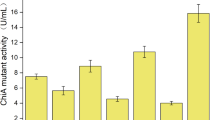Abstract
Xylella fastidiosa was the first plant pathogen whose complete genome sequence was available. X. fastidiosa causes citrus variegated chlorosis, but the physiological basis of the disease in unknown. Through comparative sequence analysis, several putative plant cell wall–degrading enzymes were identified on the X. fastidiosa genome. We have cloned Xf818, a putative endoglucanase ORF, into expression vectors pET20b and pET28b, and purified a recombinant form of Xf818 containing a His6 tag. Through biochemical assays, we have characterized the endoglucanase activity of this protein. The best conditions for hydrolysis over carboxymethyl cellulose (CMC) were on pH 5.2 at 65°C. Xf818 hydrolyzed CMC, acid swollen cellulose, Avicel, birch wood, oat spels xylans, and the oligosaccharides cellotetraose and cellopentaose. Xf818 carried out transglycosylation and had a functional cellulose-binding domain.



Similar content being viewed by others
Literature Cited
Rossetti V, Garnier M, Bové JM, Beretta MJG, Teixeira ARR, Quaggio JA, de Negri JD (1990) Présence de bactéries dans le xylème d’oranges atteints de chlorose variégée, une nouvelle maladie des agrumes au Brésil. CR Acad Sci Paris 310:345–349
Simpson AJG, Reinach FC, Arruda P, et al (2000) The genome sequence of the plant pathogen Xylella fastidiosa. Nature 406:151–159
Gough CL, Dow JM, Barber CE, Daniels MJ (1988) Cloning of two endoglucanases genes of Xanthomonas campestris pv. campestris: analysis of the role of the major endoglucanase in pathogenicity. Mol Plant-Microbe Interact 1:275–281
Roberts DP, Denny TP, Schell MA (1988) Cloning of the egl gene of Pseudomonas solanacearum and analysis of its role in phytopathogenicity. J Bacteriol 170:1445–1451
Jahr H, Dreier J, Meletzus D, Bahro R, Eichenlaub R (2000) The endo-β-1,4-glucanase CelA of Clavibacter michiganensis subsp. michiganensis is a pathogenicity determinant required for induction of bacterial wilt of tomato. Mol Plant-Microbe Interact 13:703–714
Laine MJ, Haapalainen M, Wahlross T, Kankare K, Nissinen R, Kassuwi S, Metzler MC (2000) The cellulase encoded by the native plasmid of Clavibacter michiganensis ssp. sepedonicus plays a role in virulence and contains an expansin-like domain. Physiol Mol Plant Pathol 57:221–233
Altschul SF, Gish W, Miller W, Myers EW, Lipman DJ (1990) Basic local alignment search tool. J Mol Biol 215:403–410
Gordon D, Abajian C, Greeen P (1998) Consed: a graphical tool for sequence finishing. Genome Res 8:195–202
Wulff NA, Carrer H, Pascholati SF (2003) Cloning and expression of cellulase Xf818 from Xylella fastidiosa in Escherichia coli. Scientia Agricola 60:715–721
Laemmli UK (1970) Cleavage of structural proteins during the assembly of the head of bacteriophage T4. Nature 227:680–685
Park YW, Lim ST, Yun HD (1998) Cloning and sequencing of the celA gene encoding CMCase of Erwinia carotovora subsp. carotovora LY34. Mol Cells 8:27–35
Lever M (1972) A new reaction for colorimetric determination of carbohydrates. Anal Biochem 47:273–279
Bradford MM (1976) A rapid and sensitive method for the quantitation of microgram quantities of protein utilizing the principles of protein-dye binding. Anal Biochem 72:248–254
Bounias M (1980) N-(1-naphthyl)ethylenediamine dihydrochloride as a new reagent for nanomole quantification of sugars on thin-layer plates by a mathematical calibration process. Anal Biochem 106:291–295
Park JS, Shin HS, Doi RH (2000) Fusion proteins containing cellulose-binding domains. Methods Enzymol 326:418–429
Henrissat B (1991) A classification of glycosyl hydrolases based on amino-acid sequence similarities. Biochem J 280:309–316
Gilkes NR, Henrissat B, Kilburn DG, Miller RC Jr, Warren RA (1991) Domains in microbial β-1,4-glycanases: sequence conservation, function, and enzyme families. Microbiol Rev 55:303–315
Wang Q, Tull D, Meinke A, Gilkes NR, Warren RA, Aebersold R, Withers SG (1993) Glu280 is the nucleophile in the active site of Clostridium thermocelum CelC, a family A endo-β-1,4-glucanase. J Biol Chem 268:14069–14102
Linder M, Teeri TT (1997). The roles and function of cellulose-binding domains. J Biotechnol 57:15–28
Poole DM, Hazlewood GP, Huskisson NS, Virden R, Gilbert HJ (1993) The role of conserved tryptophan residues in the interactions of a bacterial cellulose binding domain with its ligand. FEMS Microbiol Lett 106:77–84
Fry SM, Huang JS, Milholland RD (1994) Isolation and preliminary characterization of extracellular proteases produced by strains of Xylella fastidiosa from grapevines. Phytopathology 84:357–363
Eckert K, Schneider E (2003) A thermoacidophilic endoglucanase (CelB) from Alicyclobacillus acidocaldarius displays high sequence similarity to arabinofuranosidases belonging to family 51 of glycoside hydrolases. Eur J Biochem 270:3593–3602
Boyer MH, Cami B, Chambost JP, Magnan M, Cattanéo J (1987) Characterization of a new endoglucanase from Erwinia chrysanthemi. Eur J Biochem 162:311–316
Kim CH (1995) Characterization and substrate specificity of an endo-β-1,4-D-glucanase I (Avicelase I) from an extracellular multienzyme complex of Bacillus circulans. Appl Environ Microbiol 61:959–965
Boccara M, Aymeric JL, Camus C (1984) Role of endoglucanases in Erwinia chrysanthemi 3937 virulence on Saintpaulia ionantha. J Bacteriol 176:1524–1526
Acknowledgments
This work was supported by FAPESP grant-in-aid for Xylella fastidiosa Functional Genomics Project. N.A. Wulff received a PhD scholarship from FAPESP and S.F. Pascholati is a Fellow at CNPq.
Author information
Authors and Affiliations
Corresponding author
Rights and permissions
About this article
Cite this article
Wulff, N.A., Carrer, H. & Pascholati, S.F. Expression and Purification of Cellulase Xf818 from Xylella fastidiosa in Escherichia coli . Curr Microbiol 53, 198–203 (2006). https://doi.org/10.1007/s00284-005-0475-2
Received:
Accepted:
Published:
Issue Date:
DOI: https://doi.org/10.1007/s00284-005-0475-2




